GIGABYTE Server MD60-SC0 Motherboard Review: Haswell-EP with QSFP
by Ian Cutress on December 3, 2014 10:00 AM ESTGIGABYTE Server MD60-SC0 BIOS
In most server environments, the look of the BIOS is superfluous to the actual functionality, although any attempt by the manufacturer to improve the look and make it easier to use is welcome. Our recent GIGABYTE Server based reviews have looked at the base UEFI mode, similar to what used to be normal and still is when you strip away the graphical interfaces of mainstream motherboards, except there is one difference with the MD60-SC0: we have a screenshot option! Luckily I found this by accident, as it is not mentioned in the list of options on the right hand side:
Despite being an 800x600 resolution list of options, they are easier to read than some of the more consumer oriented motherboard options (!). Here on this first page we get the motherboard model, BIOS version, processors installed, CPU speed, memory installed, the memory frequency and MAC addresses of the LAN ports. While this is perhaps expecting a lot from a server grade BIOS, perhaps some CPU temperatures might be handy here as well.
The bulk of the options are in the Advanced menu, involving PCIe control, LAN control, COM configuration, fast boot/CSM and USB configuration. Users looking for Above 4G Decoding can find it in the PC Subsystem menu where it is set to disabled by default:
CSM is enabled by default, but the fan controls are a little obfuscated and hidden inside the Chipset Configuration option:
Here we get several modes for all the fan headers, including Performance, Silent, Turbo and Full Speed. On a normal consumer motherboard, we would expect a per-header breakdown with an interface to determine the fan gradients, however as this motherboard is headed for servers, ‘Performance’ fan speed will most likely be the scenario. We left our fans on performance during testing.
For a bigger breakdown of CPU configurations, the IntelRCSetup tab has the following options:
Users wanting to adjust core counts, HyperThreading and C-states can find options here, involving the Processor Configuration menu:
As well as the Power Management Configuration menu:
Here we have the BIOS by default in Energy Efficient mode, with options for Performance mode as well. This adjusts the power states in the other menus below.
For DRAM options, the Integrated Memory Controller offers users to enforce ECC, select the memory frequency or adjust the RAS Configuration:
VT-d options are via the IIO Configuration option in IntelRCSetup:
Here VT-d is enabled by default.
Error logging also has its own sub-menu:
The Server Management menu contains information regarding the Aspeed chip on board, as well as options to fix the IP address and configuration:
Secure Boot mode has options for Key Management:
Boot options are standard, with the final Save and Exit menu allowing for Boot Override.
One request to the GIGABYTE Server team would be to give the user an indication of what menu they are in. If a user ends up going through six menus to find an option, in order to help other users find the same option, by having the screenshot say where they are it might help. MSI did this on their consumer range recently at my request, and it went down well. Apart from this, some finer control over the fans would be good.
GIGABYTE Server MD60-SC0 Software
As with GIGABYTE Server’s other motherboards, OS software is non-existent. The only software to mention is that provided by the Aspeed management chip, accessed through the web interface on another machine. This software is based on the MergePoint Management interface, integrated with GIGABYTE’s logos, and offers the typical server management options we have seen previously.
The latest firmware was pre-installed on our sample, dated for August. The Aspeed 2400 is recognized here as well to differentiate itself from the Aspeed 2300 setups we have encountered previously.
Nothing in the MergePoint system is new from our perspective, and starting from the top we have the Network and Network Security:
The management system allows a maximum of 16 named users. The default user is ‘admin’.
Web server details can also be defined:
An administrator can update the BIOS/ME of the motherboard through this interface as well with a pre-downloaded file from GIGABYTE’s website. This is particularly helpful to update the system without entering the BIOS or updating through the OS. It will however terminate all other sessions.
As with other server motherboards, there are sensors all over the place. The management interface has an adequate list of everything a user might need:
One missing feature is the ability to set the non-critical and critical boundaries for each of the sensors separately.
Power control is an important part of server management, and here is our list of options.
The System Event Log captures all boots, reboots or sensor trips. I have used this several times in previous reviews when unable to get an image to display on a monitor.
The management software also allows direct Java-based KVM control of the system as well.



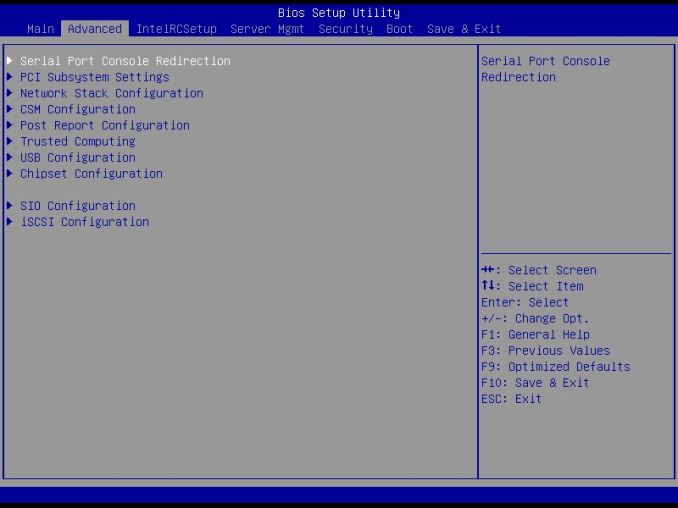

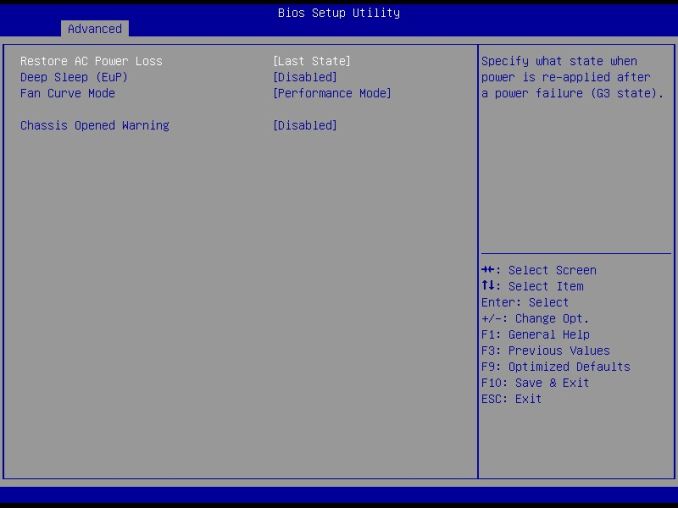
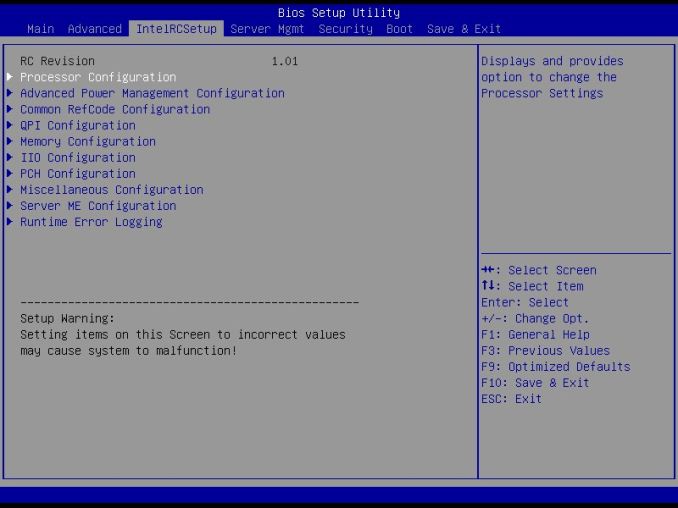
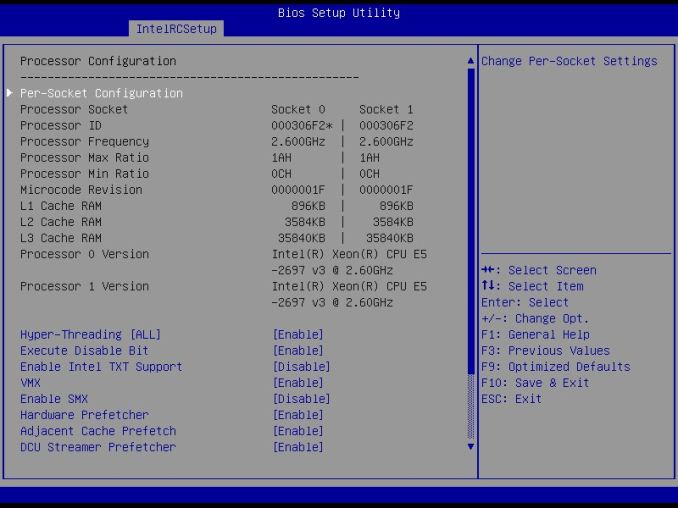
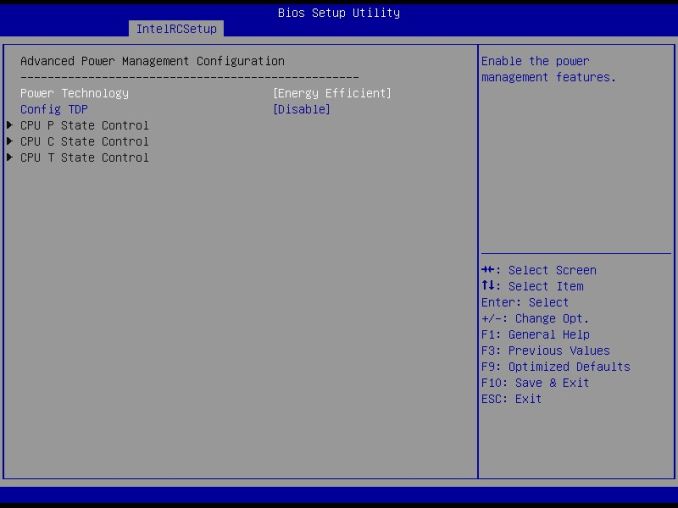
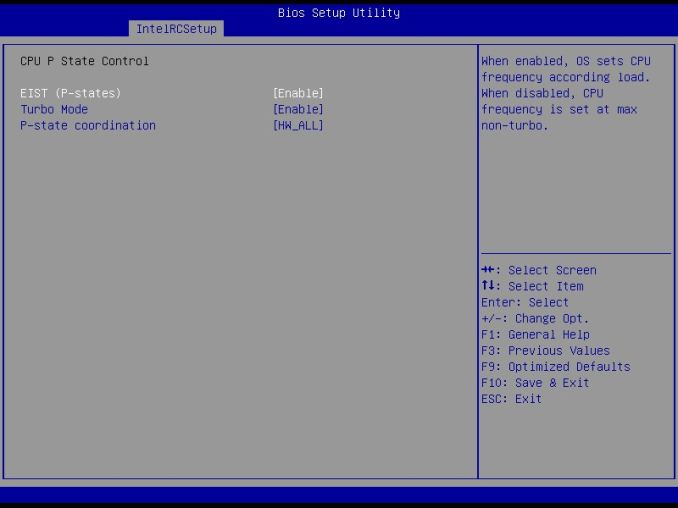
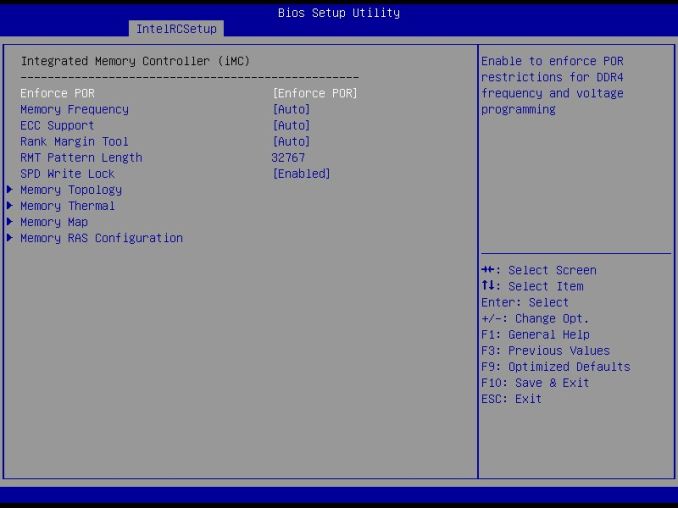
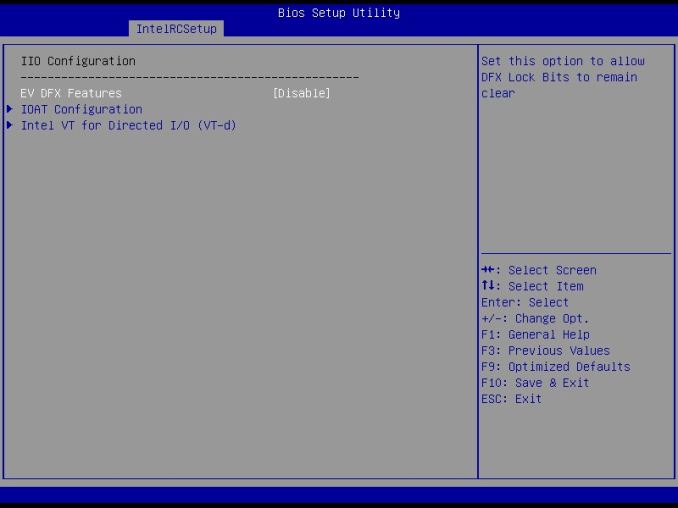
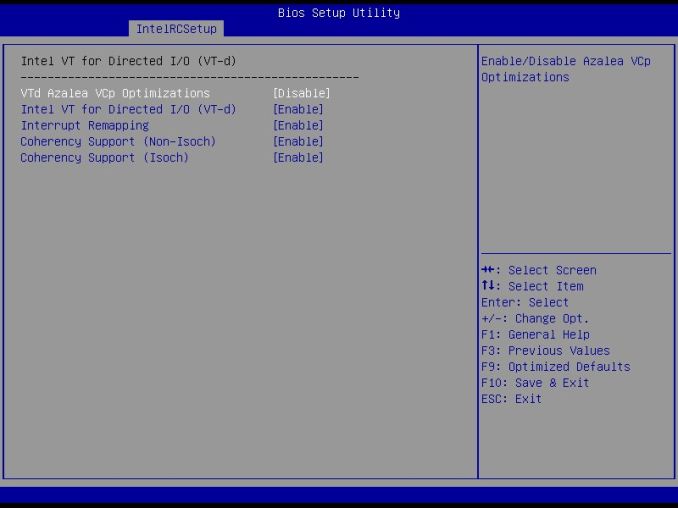
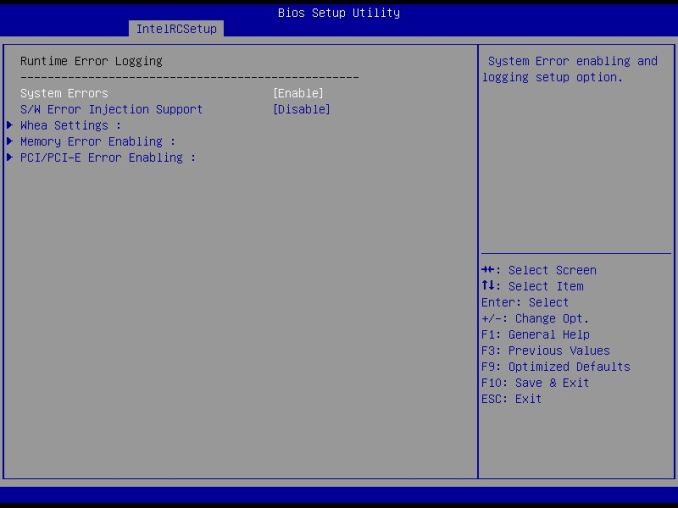
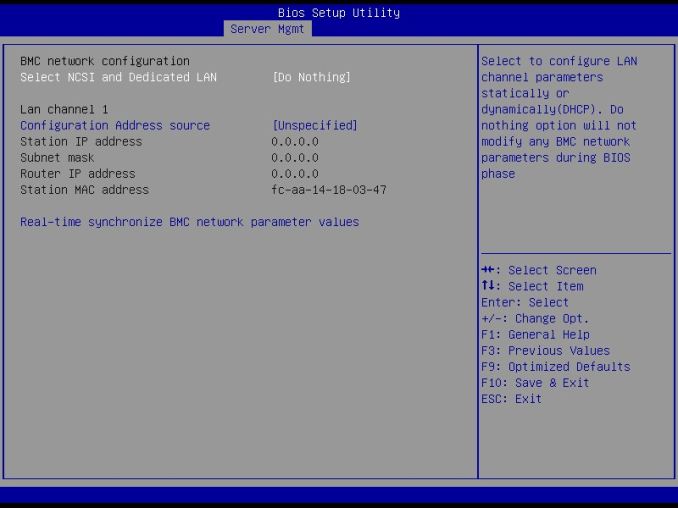

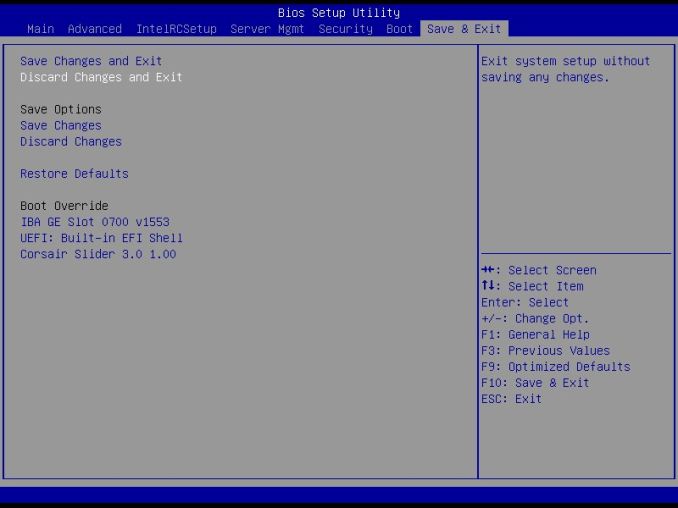






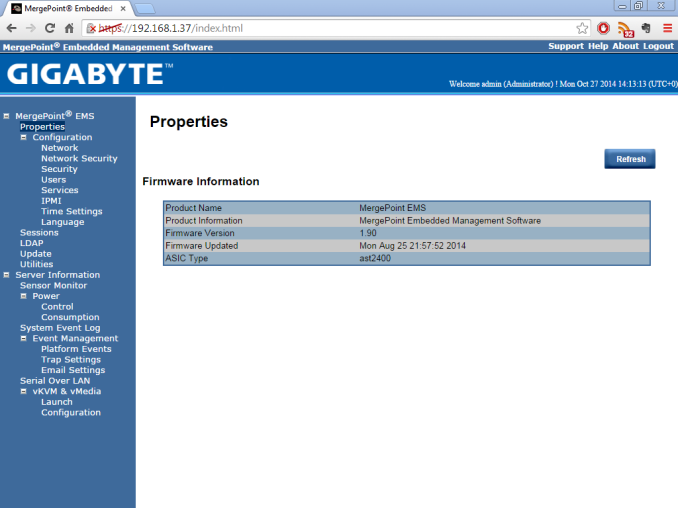
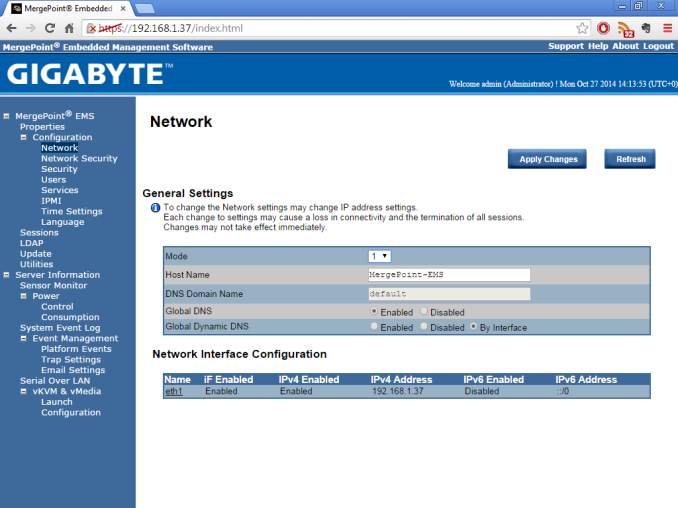
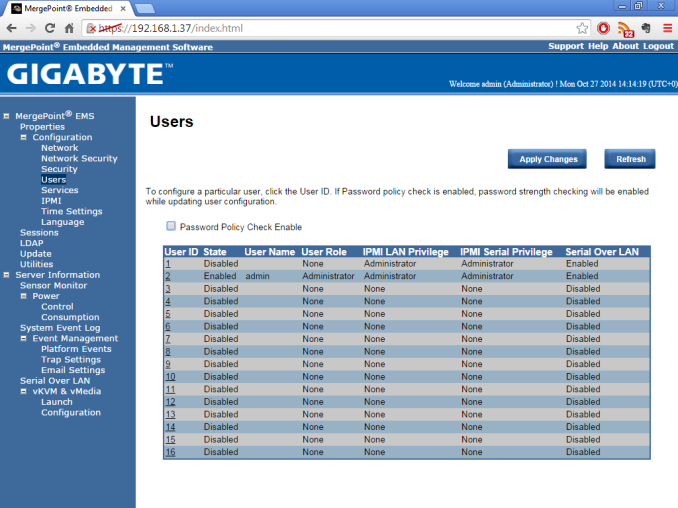
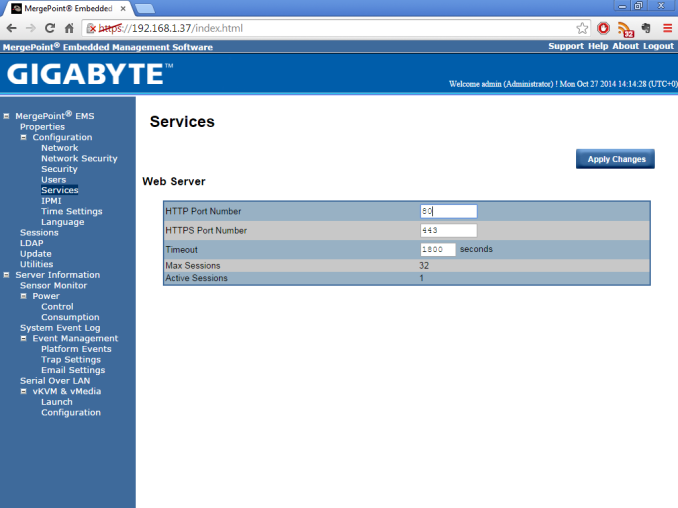

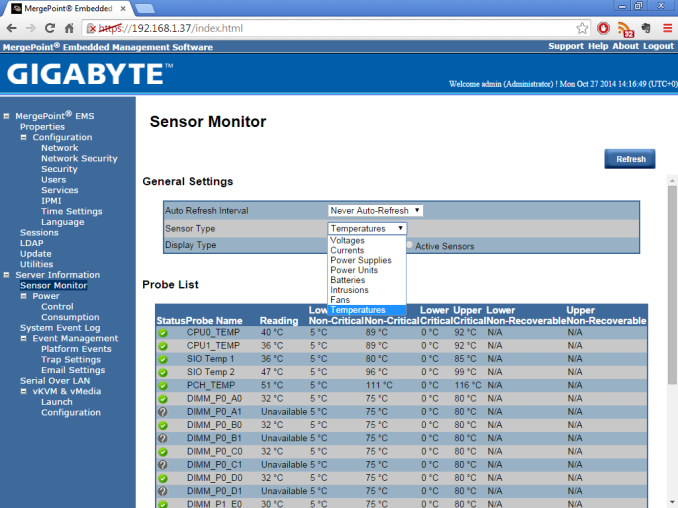
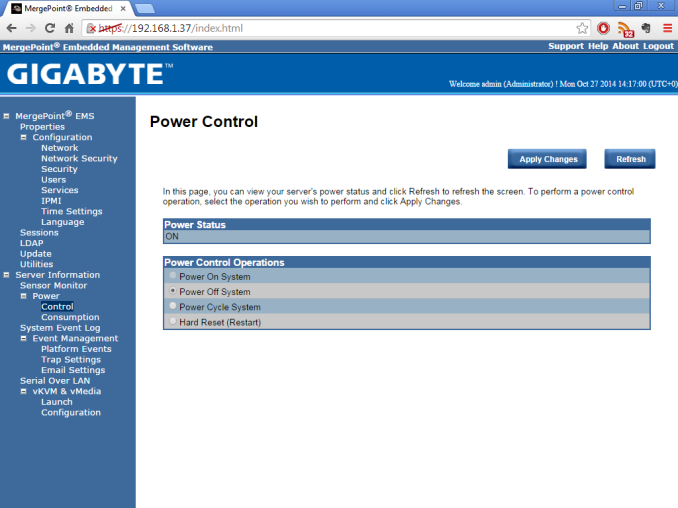
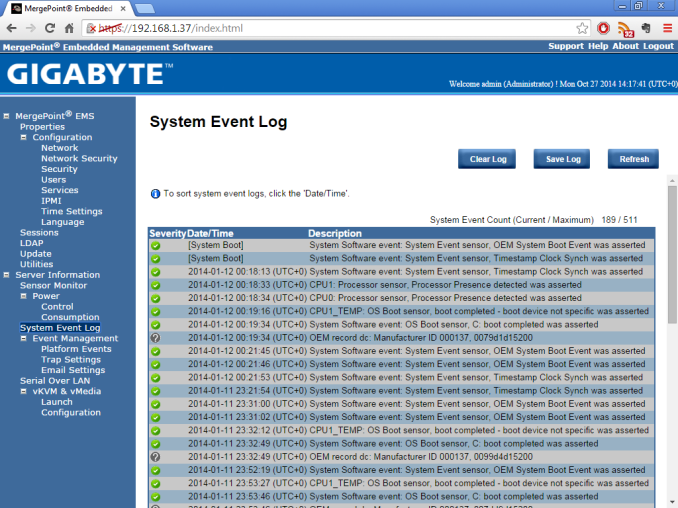
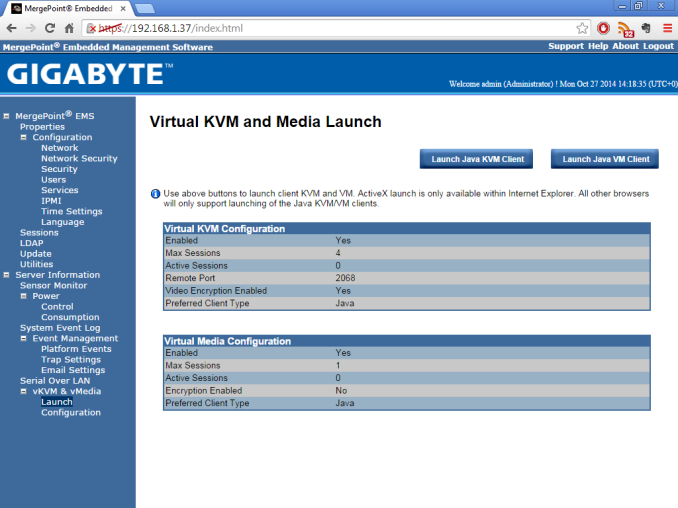














17 Comments
View All Comments
macwhiz - Wednesday, December 3, 2014 - link
I'm not surprised that there's no temperature data in the BIOS. Server admins don't look at the BIOS after they complete initial setup (or a major overhaul). It's accessible from the BMC, where it's useful in a server environment. When a server overheats, the admin is usually not in the same room—and often not in the same building, or even the same state. The important question is how the BMC firmware does at exposing that data for out-of-band management via IPMI, SNMP, or another standard solution. Does it play well with an Avocent UMG managment device, for instance? As a server admin, I could care less about seeing the temperature in the BIOS. What I care about is that my chosen monitoring solution can see if the temperature is going up—or any hardware fault is detected—and page me, even if the operating system isn't running. That's what BMCs are for!Don't apologize for using 240VAC power. Chances are very good that, even in a U.S. data center, it'll be on 240VAC power. Given the current needs of most servers, it's impractical to use 120VAC power in server racks—you'll run out of available amperage on your 120VAC power-distribution unit (power strip) long before you use all the outlets. Keep going down that road and you waste rack space powering PDUs with two or three cords plugged into them. It's much easier and more efficient all the way around to use 240VAC PDUs and power in the data center. Comparing a 20-amp 120V circuit to a 20-amp 240V circuit, you can plug at least twice as many of a given server model into the 240V circuit. Because the U.S. National Electrical Code restricts you to using no more than 80% of the rated circuit capacity for a constant load, you can plug in 16A of load on that 20A circuit. If the servers draw 6A at 120V or 3A at 240V, you can plug in two servers to the 120V power strip, or five servers into the 240V strip, before you overload it. So, once you get beyond a handful of computers, 240V is the way to go in the datacenter (if you're using AC power).
leexgx - Wednesday, December 3, 2014 - link
mass server racks are Pure DC in some cases or 240v (i would of thought there be some very basic Temp monitoring in the BIOS but guess most of this is exposed elsewhereso i agree with this post
jhh - Thursday, December 4, 2014 - link
208V 3-phase is probably more popular than 240V, as most electricity is generated as 3-phase, and using all 3 phases is important for efficiently using the power without being charged for a poor power factor.mapesdhs - Thursday, December 4, 2014 - link
In, you're still using the wrong source link for the C-ray test. The Blinkenlights site is
a mirror over which I have no control; I keep the main c-ray page on my SGI site.
Google for, "sgidepot 'c-ray'", 1st hit will be the correct URL.
Apart from that, thanks for the review!
One question: will you ever be able to review any quad-socket systems or higher?
I'd love to know how well some of the other tests scale, especially CB R15.
Ian.
fackamato - Friday, December 5, 2014 - link
No 40Gb benchmarks?sor - Monday, December 8, 2014 - link
I was excited to see the QSFP, but it seems like it's not put to use. I've been loving our mellanox switches, they have QSFP and you can run 40Gbe or 4 x 10Gbe with a breakout cable, with each port. It provides absolutely ridiculous port density and great cost. You can find SX1012s (12 port QSFP) for under $5k, and have 48 10G ports in 1/2U at about $100/port. No funny business with extra costs to license ports. The twinax cable is much cheaper than buying 10G optics, too, but you have to stay close. Usually you only need fibre on the uplinks, anyway.dasco - Saturday, March 9, 2019 - link
Does it support udimm. As the documentation says that it supports only rdimm or lrdimm.Does gskill ram used in this test is udimm or rdimm Ecc ram.